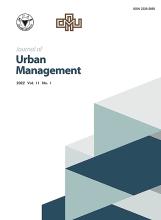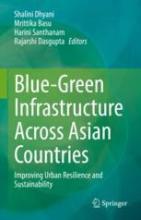Publications

|
Gufran Beig co-authored Sir Ashutosh Mukherjee Chair Professor, School of Natural Sciences and Engineering Process-based Diagnostics of Extreme Pollution Trail using Numerical Modelling during Fatal Second COVID-19 wave in the Indian Capital https://www.sciencedirect.com/science/article/pii/S0045653522007640?via%3Dihub= Chemosphere, 298 |

|
Harini Santhanam co-authored Assistant Professor, Energy, Environment and Climate Change Programme Ecosystem-based approaches to develop a monitoring framework for restoring the transitional lagoon ecosystem of Pulicat, India https://doi.org/10.1016/j.ecoleng.2022.106608 Ecological Engineering, Volume 179, June 2022 (Co-authored with Shalini Dhyani, and Sudip Kumar Kundu) An analysis of the transformational processes, habitat fragmentation and resilience of Pulicat lake, India, a coastal ecosystem is presented in this co-authored publication.
|

|
C P Rajendran Adjunct Professor, School of Natural Sciences and Engineering Living in Metaverse https://newspaper.mathrubhumi.com/features/edit-page/humans-in-the-meta-world-1.7411294 Mathrubhumi (Kerala Daily) The world that is transitioning into a metaverse, thanks to Mark Zuckerberg and Bill Gates, holds unpredictable consequences on social relations in a post-truth world. |

|
Sayan Banerjee PhD Scholar, Animal Behaviour and Cognition Programme Book Review: A fraught tale of the Mishmis, their tigers and the world beyond https://science.thewire.in/environment/book-review-tigers-are-our-brothers-mishmi-tigers-world-beyond/ The Wire Science This is a book review of Tigers Are Our Brothers: Anthropology of Wildlife Conservation in Northeast India, authored by Dr. Ambika Aiyadurai. The review discusses the key themes and takeaways from the book. |

|
G Parthasarathy co-authored INSA Scientist, School of Natural Sciences and Engineering Geoenvironment and weathering of silicate minerals in sediments of the Brahmaputra River, India: Implications for heavy metal pollution assessment https://www.sciencedirect.com/science/article/pii/S2772883822000425?utm_campaign=STMJ_AUTH_SERV_PUBLISHED&utm_medium=email&utm_acid=204001724&SIS_ID=… Geosystems and Geoenvironment |
| |
Anindya Sinha co-authored Professor, Animal Behaviour and Cognition Programme The Rurban elephant: Behavioural ecology of Asian elephants in response to large-scale landuse change in a human-dominated landscape in peri-urban southern India https://link.springer.com/chapter/10.1007/978-981-16-3738-4_16 New Forms of Urban Agriculture: An Urban Ecology Perspective (Eds. Diehl J A and Kaur H). Springer Nature, Singapore, March 2022 pp. 289-310 In this chapter, we assess the impacts of such transformations on the lives of India’s largest land mammal, the Asian elephant and discuss the adaptations displayed by this species to human-induced change, with a particular focus on how the successful exploitation of rurban agricultural resources has allowed for the appearance of spatially and temporally flexible behavioural innovations that, in turn, have impacted the life-history strategies of a threatened elephant population in a peri-urban region of southern India |

|
Harini Santhanam, Rudrodip Majumdar Assistant Professors, Energy, Environment and Climate Change Programme Quantification of green-blue ratios, impervious surface area and pace of urbanisation for sustainable management of urban lake - land zones in India -a case study from Bengaluru city https://authors.elsevier.com/sd/article/S2226-5856(22)00018-8 Journal of Urban Management, Elsevier, 28 March 2022 The study describes the creation of four simple metrics to estimate: 1. the ratio of ‘green’ vegetated areas to the ‘blue’ water spread areas, defined as the ‘Green-blue ratio’ (GBA); 2. The ratio of ‘blue’ water spread areas to ‘built-up’ ratio around the lakes, defined as the ‘Blue to Built-up ratio’ (BBA), 3. the percentage of impervious surface area (ISA) and 4. the pace of urbanisation in the dynamic zones (DZ) of urban lake environments. |

|
Kuili Suganya, Mythrayi Harshavardhan, M B Rajani Kuili Suganya is PhD Scholar; Mythrayi Harshavardhan is Project Associate; M B Rajani is Associate Professor, Heritage Science and Society Programme The Significance of Ancient Water Systems and the Sacred Groves in the Landscape of Badami, Karnataka: A Geospatial Study https://doi.org/10.1007/978-981-16-7128-9_17 Dhyani, S., Basu, M., Santhanam, H., Dasgupta, R. (eds) Blue-Green Infrastructure Across Asian Countries. Springer, Singapore. This chapter discusses the modifications carried out in the landscape of Badami in Karnataka to harvest water for the settlement since its establishment as an Early Chalukyan capital in the seventh century. The chapter also highlights the significance of sacred groves in the historic landscape of Badami. The remnants of fortified walls, temples, water features, and sacred grooves testify to the ingenious engineering systems that existed in the past. |
